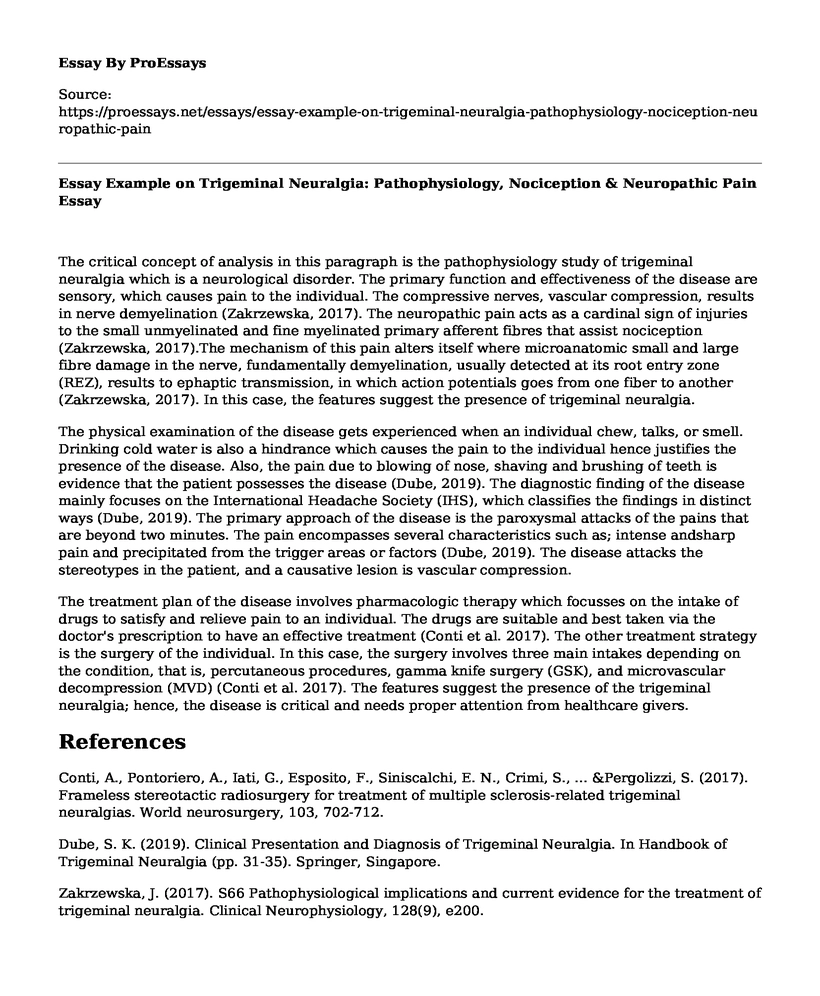The critical concept of analysis in this paragraph is the pathophysiology study of trigeminal neuralgia which is a neurological disorder. The primary function and effectiveness of the disease are sensory, which causes pain to the individual. The compressive nerves, vascular compression, results in nerve demyelination (Zakrzewska, 2017). The neuropathic pain acts as a cardinal sign of injuries to the small unmyelinated and fine myelinated primary afferent fibres that assist nociception (Zakrzewska, 2017).The mechanism of this pain alters itself where microanatomic small and large fibre damage in the nerve, fundamentally demyelination, usually detected at its root entry zone (REZ), results to ephaptic transmission, in which action potentials goes from one fiber to another (Zakrzewska, 2017). In this case, the features suggest the presence of trigeminal neuralgia.
The physical examination of the disease gets experienced when an individual chew, talks, or smell. Drinking cold water is also a hindrance which causes the pain to the individual hence justifies the presence of the disease. Also, the pain due to blowing of nose, shaving and brushing of teeth is evidence that the patient possesses the disease (Dube, 2019). The diagnostic finding of the disease mainly focuses on the International Headache Society (IHS), which classifies the findings in distinct ways (Dube, 2019). The primary approach of the disease is the paroxysmal attacks of the pains that are beyond two minutes. The pain encompasses several characteristics such as; intense andsharp pain and precipitated from the trigger areas or factors (Dube, 2019). The disease attacks the stereotypes in the patient, and a causative lesion is vascular compression.
The treatment plan of the disease involves pharmacologic therapy which focusses on the intake of drugs to satisfy and relieve pain to an individual. The drugs are suitable and best taken via the doctor's prescription to have an effective treatment (Conti et al. 2017). The other treatment strategy is the surgery of the individual. In this case, the surgery involves three main intakes depending on the condition, that is, percutaneous procedures, gamma knife surgery (GSK), and microvascular decompression (MVD) (Conti et al. 2017). The features suggest the presence of the trigeminal neuralgia; hence, the disease is critical and needs proper attention from healthcare givers.
References
Conti, A., Pontoriero, A., Iati, G., Esposito, F., Siniscalchi, E. N., Crimi, S., ... &Pergolizzi, S. (2017). Frameless stereotactic radiosurgery for treatment of multiple sclerosis-related trigeminal neuralgias. World neurosurgery, 103, 702-712.
Dube, S. K. (2019). Clinical Presentation and Diagnosis of Trigeminal Neuralgia. In Handbook of Trigeminal Neuralgia (pp. 31-35). Springer, Singapore.
Zakrzewska, J. (2017). S66 Pathophysiological implications and current evidence for the treatment of trigeminal neuralgia. Clinical Neurophysiology, 128(9), e200.
Cite this page
Essay Example on Trigeminal Neuralgia: Pathophysiology, Nociception & Neuropathic Pain. (2023, Mar 12). Retrieved from https://proessays.net/essays/essay-example-on-trigeminal-neuralgia-pathophysiology-nociception-neuropathic-pain
If you are the original author of this essay and no longer wish to have it published on the ProEssays website, please click below to request its removal:
- Safety Plan
- Changing of Term Mental Retardation to Intellectual Disability - Essay Sample
- Anemia: Pathophysiology, Patient Factors, and Management - Essay Sample
- Holistic Care of Dementia Patients: Nursing Staff's Competencies and Challenges - Research Paper
- Essay Example on XYZ Cosmetics: Sensitive Skincare for Allergy-Prone Skin
- Essay Example on HIPAA: Leveraging Privacy and Security of PHI in Healthcare
- Myocardial Infarction: A Case Study on a 64-Year-Old Patient with Mechanical Complications







